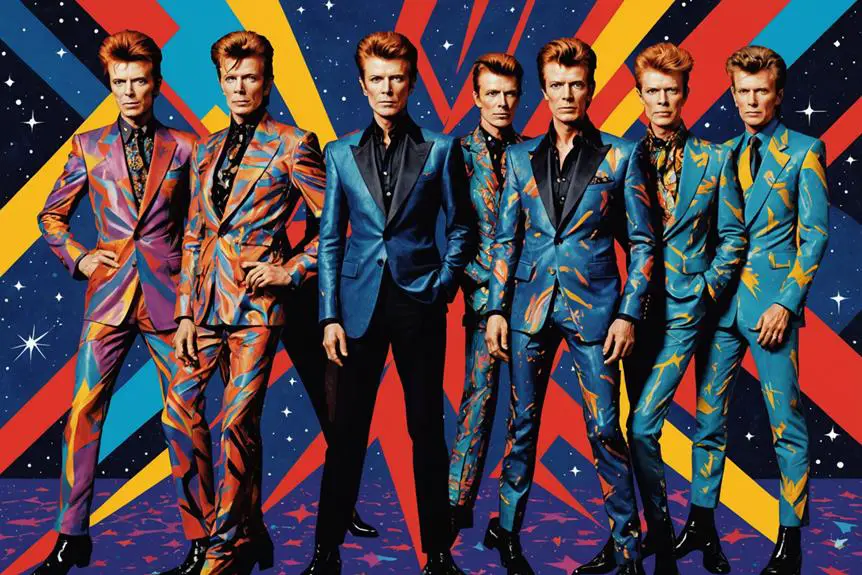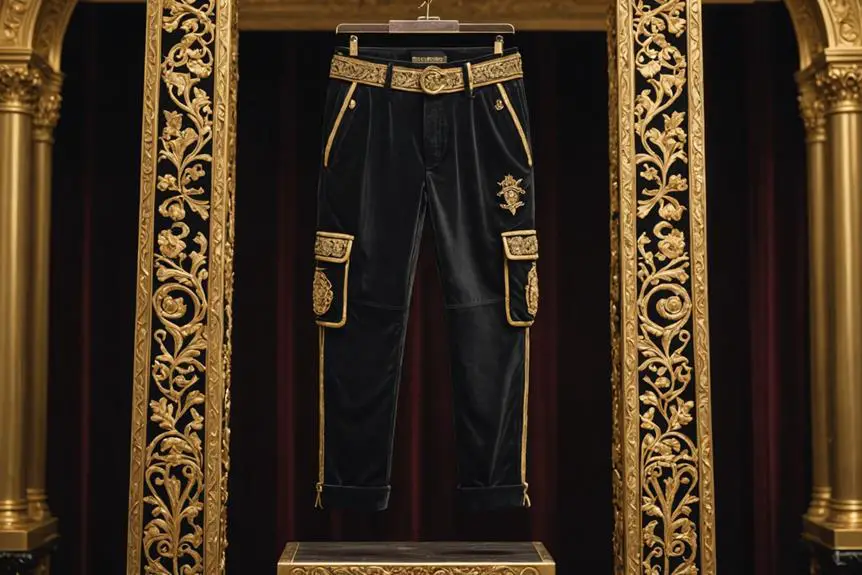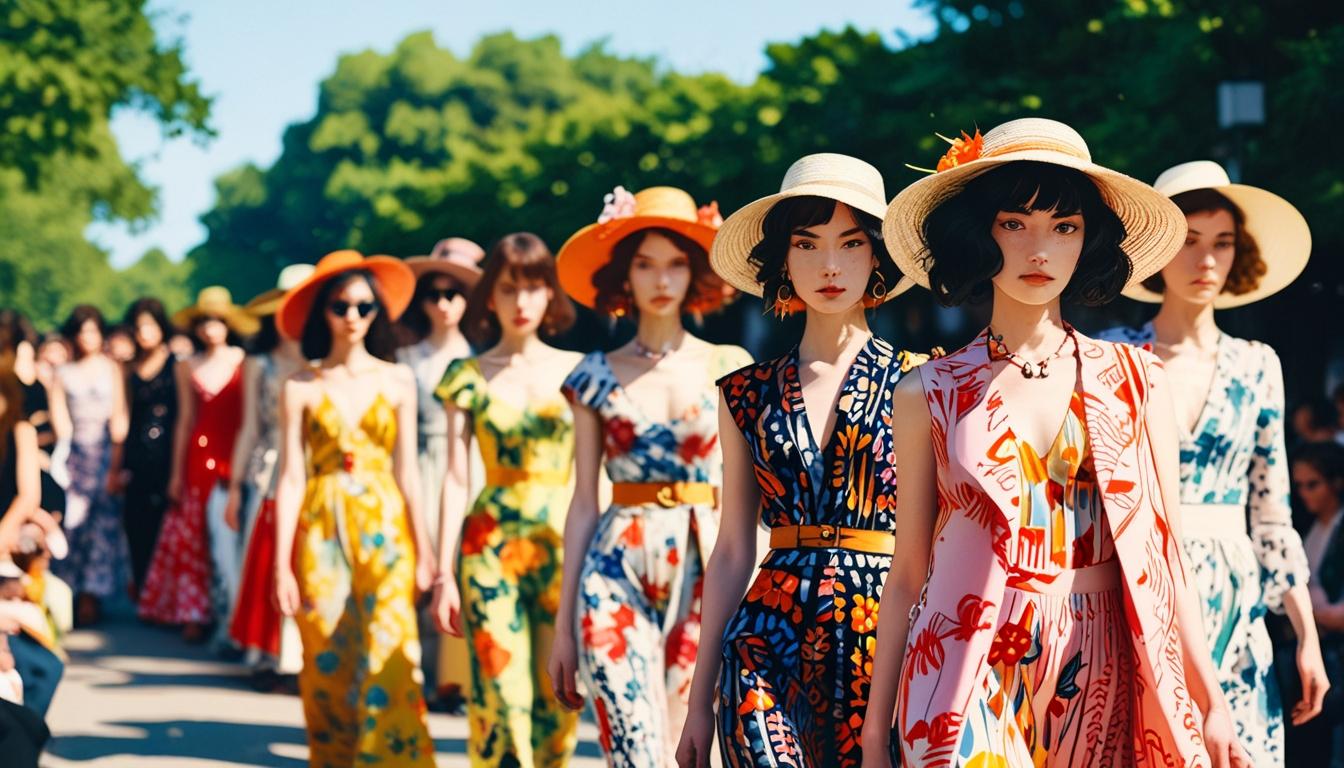David Bowie's ever-changing wardrobe is like a kaleidoscope, reflecting the shifting tides of culture and identity. You've likely noticed how each of his iconic looks tells a story, pushing boundaries and challenging the norms of his time. From the vibrant hues of his glam rock ensembles to the futuristic cuts that defined his persona, there's a deeper significance behind every stitch. What fuels this relentless reinvention, and how did it influence not just music but the very fabric of fashion itself?
David Bowie: A Fashion Pioneer
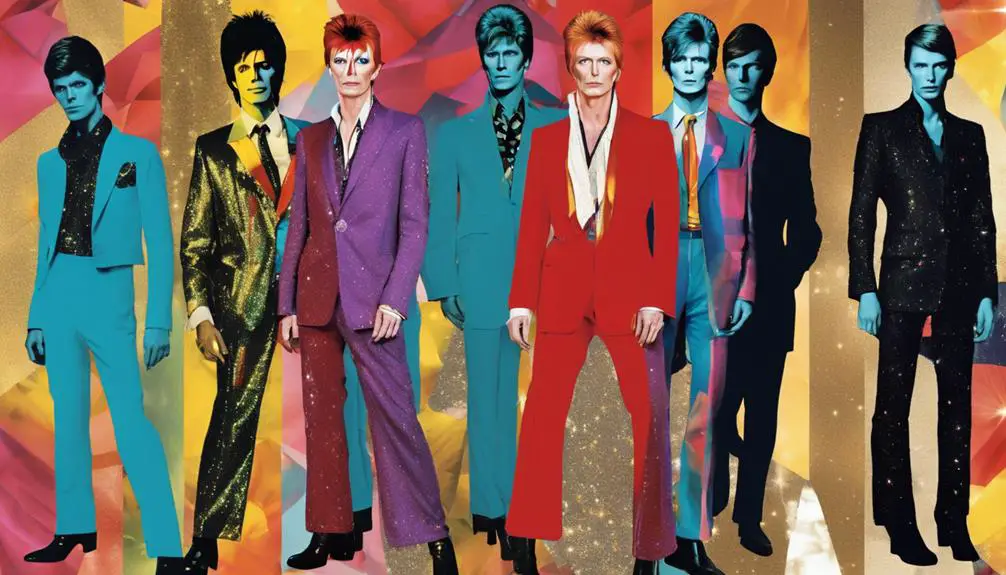
David Bowie's bold choices in fashion set him apart as a true pioneer in the music world. You can't talk about Bowie without mentioning his iconic Ziggy Stardust persona. Remember that one-armed jumpsuit designed by Freddie Burretti? It wasn't just a costume; it was a statement—an explosion of androgynous glam rock aesthetics that challenged the norms around gender and sexuality.
Then there's the unforgettable cover of "The Man Who Sold the World," where Bowie rocked a floral dress by Michael Fish. Can you believe how he flipped traditional expectations upside down? That's pure Bowie magic! And let's not forget his collaboration with Japanese designer Kansai Yamamoto, which brought us bold pieces like the wide-legged vinyl jumpsuit. Talk about fashion moments that made waves!
With his Aladdin Sane album, he continued to push boundaries, blending music with art and style in ways that were totally revolutionary. Even in the 1996 Earthling era, Bowie sported a Union Jack coat designed by the legendary Alexander McQueen, further cementing his role as a fashion innovator.
Bowie wasn't just about looking good; he was about reinventing himself and encouraging others to do the same. His legacy still influences artists and designers today. So, the next time you think about fashion, remember how Bowie taught us to express ourselves boldly and authentically. Isn't that something to celebrate?
The Evolution of Bowie's Style
Bowie's style journey is a fascinating evolution that reflects his ever-changing artistic vision. From the early 1970s, when he burst onto the scene as Ziggy Stardust, you could see his wild androgynous fashion choices. Think flamboyant jumpsuits and striking makeup—talk about a fashion moment! It was glam rock at its finest, and Bowie had everyone talking.
Then, the 1980s rolled in, and Bowie shifted gears. He embraced a more polished look, rocking three-piece suits with flair. But don't think he lost his edge; he still threw in unique pieces like that flamingo pink wide-lapel blazer during a 1991 performance. You've gotta love how he kept things fresh!
The 1990s brought a blend of nostalgia and modernity, with the iconic Union Jack coat designed by Alexander McQueen for his Earthling album. This coat wasn't just clothing; it symbolized his British roots and his lasting influence in fashion. Talk about a bold statement!
In his later years, Bowie continued to surprise us. He mixed classic styles with contemporary flair. Remember that embroidered floral dress coat he wore at Glastonbury in 2000? It showed he could adapt while staying true to himself.
Through it all, the evolution of Bowie's style pushed boundaries and sparked conversations about gender expression in fashion. Isn't it amazing how one person can inspire so many? Bowie's fearless approach to style continues to influence artists today.
Iconic Fashion Moments of the 1970s
The 1970s marked some of the most iconic fashion moments in David Bowie's career, where his daring choices set the stage for a generation of style. You can't talk about Bowie without mentioning his incredible Aladdin Sane Tour in 1973. Bowie created a buzz wearing a wide-legged vinyl jumpsuit designed by Kansai Yamamoto, showcasing his flair for bold and extravagant fashion. That outfit alone could make anyone want to step out in style!
In 1973, he strutted through Paris with striking red hair and a shiny blue blazer that screamed flamboyance. It's like he turned the streets into his runway! Plus, during a gig in London that same year, Bowie wore a silk ensemble inspired by "A Clockwork Orange." How cool is that? He knew how to blend cinematic influences with his fashion choices seamlessly.
Fast forward to 1974, and he rocked a red-and-black costume during his "Rebel Rebel" performance, embracing a rock pirate aesthetic. Talk about iconic! And let's not forget the 1978 Vogue feature, where Bowie showcased a casual yet elegant look that perfectly captured his essence as a style icon, blending simplicity with a Greek god-like presence. Isn't it amazing how his stage costumes and everyday outfits still inspire fashion as well? David Bowie truly redefined what it meant to be fashionable in the '70s, and his legacy lives on!
Collaborations With Renowned Designers
Collaborating with renowned designers, David Bowie pushed the boundaries of fashion in ways that resonated deeply with his artistic vision. You can't talk about Bowie without mentioning his wild partnerships that made him a fashion innovator. Take his collaboration with Japanese designer Kansai Yamamoto, for example. Together, they created iconic pieces like the wide-leg vinyl jumpsuit, which became a staple during his Aladdin Sane tour in 1973. Those striking costumes weren't just clothes; they were a vibrant explosion of color and theatricality that defined glam rock!
And let's not forget about the stunning floral dress designed by Michael Fish for his 1971 album cover, "The Man Who Sold the World." This look was a bold statement, showcasing Bowie's early embrace of gender fluidity in fashion. Pretty cool, right?
Fast forward to 1997, and you've got the iconic Union Jack coat designed by Alexander McQueen for the Earthling album. This coat didn't just symbolize British fashion; it proved Bowie's lasting influence in the fashion world. His collaborations with designers like Freddie Burretti and McQueen not only shaped his unique style but also inspired countless others in the industry.
Bowie's Impact on Gender Fluidity
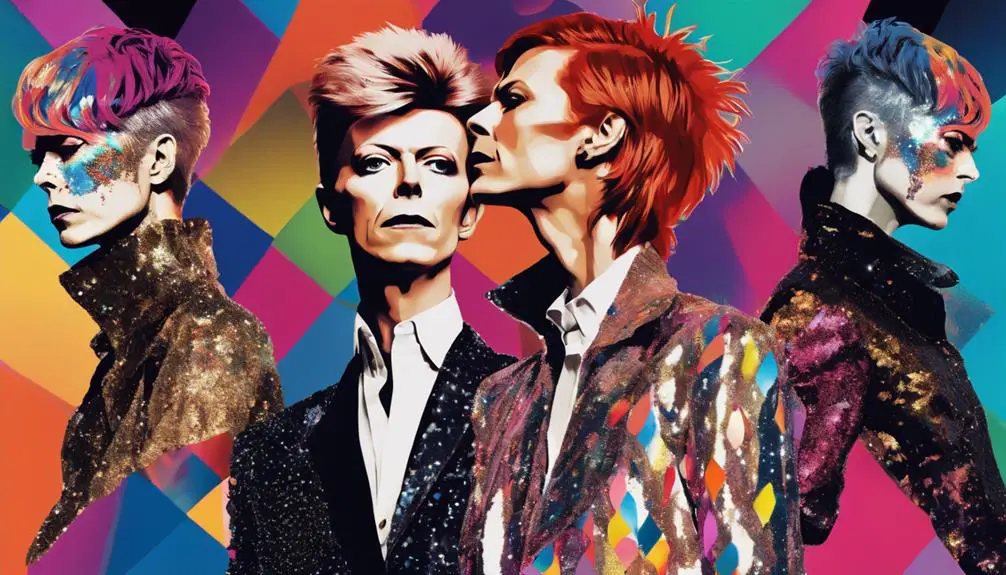
Challenging traditional gender norms, David Bowie became a trailblazer for gender fluidity in fashion. You can't talk about the glam rock movement without mentioning Bowie's wild, androgynous styles that flipped the script on what it meant to express oneself. Remember that iconic album cover for "The Man Who Sold the World"? There he was, donning a floral dress, boldly questioning conventional masculinity. It was a game changer!
Bowie's fashion choices were anything but ordinary. He dazzled us with bold colors, flamboyant costumes, and theatrical outfits that celebrated diversity. His looks weren't just about clothes; they were a statement about freedom and self-expression. Collaborating with visionary designers like Kansai Yamamoto, Bowie created unforgettable pieces, like the one-armed jumpsuit. Seriously, who else could pull that off?
His embrace of gender fluidity inspired countless artists and fashion lovers, showing them that it's okay to break the mold. When you think about it, Bowie wasn't just a musician; he was a movement, pushing boundaries and opening doors for everyone. How cool is that?
Lasting Influence on Modern Fashion
Bowie's groundbreaking approach to fashion didn't just shake up the music scene; it laid the groundwork for modern designers to explore androgyny and self-expression. His wild style moments, especially during the Ziggy Stardust era, are still turning heads today. Can you believe how far his influence stretches? Designers like Alexander McQueen have taken cues from Bowie, blending theatricality with bold, androgynous styles that challenge conventional norms.
Remember that stunning Union Jack coat McQueen designed for Bowie's Earthling album? It didn't just scream British pride; it symbolized the perfect fusion of music and fashion. That coat is a demonstration of how style can express identity, something that's more relevant now than ever.
Bowie's fearless attitude toward fashion pushed boundaries and inspired countless artists to embrace fluidity in their own looks. His song "Fashion" from 1980? It's a catchy reminder that style isn't just about clothes; it's a form of personal expression!
Bowie's Alter Egos and Their Styles
Through his iconic alter egos, David Bowie redefined the landscape of fashion, each character serving as a canvas for bold self-expression. You can't help but admire how Bowie's wild personas changed the game. Take Ziggy Stardust, for instance. This flamboyant character rocked a vibrant jumpsuit designed by Freddie Burretti, complete with bright stripes and strong shoulders. It was a fashion statement that screamed glam rock!
Then there's Aladdin Sane, who introduced a daring wide-legged vinyl jumpsuit by Kansai Yamamoto. This look became legendary, especially during live performances, where Bowie truly shone. You could see how each outfit reflected the energetic spirit of the glam rock movement. But don't forget about the Thin White Duke, who emerged in the mid-1970s. This persona sported tailored three-piece suits and high-waisted trousers, showing off a more sophisticated side. It's like he was saying, "I can be stylish and complex!"
And let's not overlook Halloween Jack from the Diamond Dogs album. With a dramatic plunging patterned shirt and an eye patch, this rebellious character challenged norms and made you think twice about what fashion could be. Bowie didn't just wear these outfits; he transformed them into symbols of individuality and freedom. So, which alter ego speaks to you? Each one is a reminder that fashion is about more than just clothes—it's a way to express who you really are!
Celebrating Bowie's Unique Aesthetic
When you think of David Bowie, his androgynous outfits probably pop into your mind, right? From his fab zig-zag jumpsuit to those wild vinyl looks created with Kansai Yamamoto, Bowie truly redefined what fashion could be. Let's celebrate how his iconic designs not only turned heads but also sparked conversations about style and identity!
Androgyny in Fashion
In the domain of fashion, few figures have embraced androgyny as boldly as David Bowie, particularly through his iconic Ziggy Stardust persona. His wild, androgynous style shattered traditional gender norms in the 1970s. From bold makeup to flamboyant clothing, Bowie mixed masculine and feminine elements like a pro. Remember that unforgettable album cover for "The Man Who Sold the World"? Bowie rocked a floral dress, making waves in a world that wasn't ready for it!
His collaborations with avant-garde designers, like Kansai Yamamoto, brought us daring pieces such as the wide-legged vinyl jumpsuit and the fabulous blue feather boa. Talk about making a statement! Bowie's costumes weren't just outfits; they were a form of self-expression that resonated deeply with the LGBTQIA+ community and inspired artists for generations.
Here are some highlights of Bowie's androgynous fashion moments:
- Ziggy Stardust's colorful makeup
- The iconic vinyl jumpsuit
- That stunning floral dress
- The fabulous blue feather boa
Bowie's influence still shines in today's fashion world, where blending styles is celebrated. Isn't it amazing how his legacy continues to inspire?
Iconic Collaborations and Designs
David Bowie's collaborations with visionary designers redefined the landscape of fashion, merging art and identity in ways that still resonate today. Think about his wild jumpsuit designed by Kansai Yamamoto, which became iconic during the Ziggy Stardust and Aladdin Sane tours. You can almost picture him strutting around in those wide-legged vinyl pants and platform boots, right?
Then there's the floral dress he wore on the cover of "The Man Who Sold the World," designed by Michael Fish. It challenged traditional gender norms and showed how Bowie explored fluidity in identity. How cool is that?
Don't forget his Union Jack coat by Alexander McQueen for the "Earthling" album. It's a symbol of his British roots and his ever-evolving fashion sense in the '90s. Plus, the Halloween Jack persona during the "Diamond Dogs" album featured a dramatic costume by Freddie Burretti, complete with a plunging shirt and eye patch.
Bowie's ability to blend theatricality with personal expression, like his embroidered floral dress coat at Glastonbury in 2000, proves he'll always be a lasting influence on the music and style scene. So, let's look back and celebrate his unique aesthetic!
Frequently Asked Questions
How Is David Bowie a Fashion Icon?
You see Bowie's androgyny redefining glam rock, showcasing fashion evolution through style experimentation. His persona transformations created cultural impact, inspiring countless artists to embrace fluidity and self-expression, solidifying his status as a true fashion icon.
What Made David Bowie Iconic?
You'll find David Bowie iconic due to his musical evolution, embrace of gender fluidity, and profound cultural impact. His theatrical performance and artistic persona shaped celebrity influence, inspiring countless artists and redefining norms across generations.
What Kind of Clothes Did David Bowie Wear?
David Bowie's clothes blended glam rock and space age aesthetics, featuring androgynous styles and theatrical outfits. You'd see bold colors and vintage influences, reflecting his unique identity and challenging traditional fashion norms.
What Designers Did David Bowie Wear?
Bowie's collaborations with costume designers like Kansai Yamamoto and Freddie Burretti shaped his personal aesthetic. His vintage styles and avant-garde fashion in stage outfits reflected a unique blend of creativity, challenging norms and inspiring future generations.
